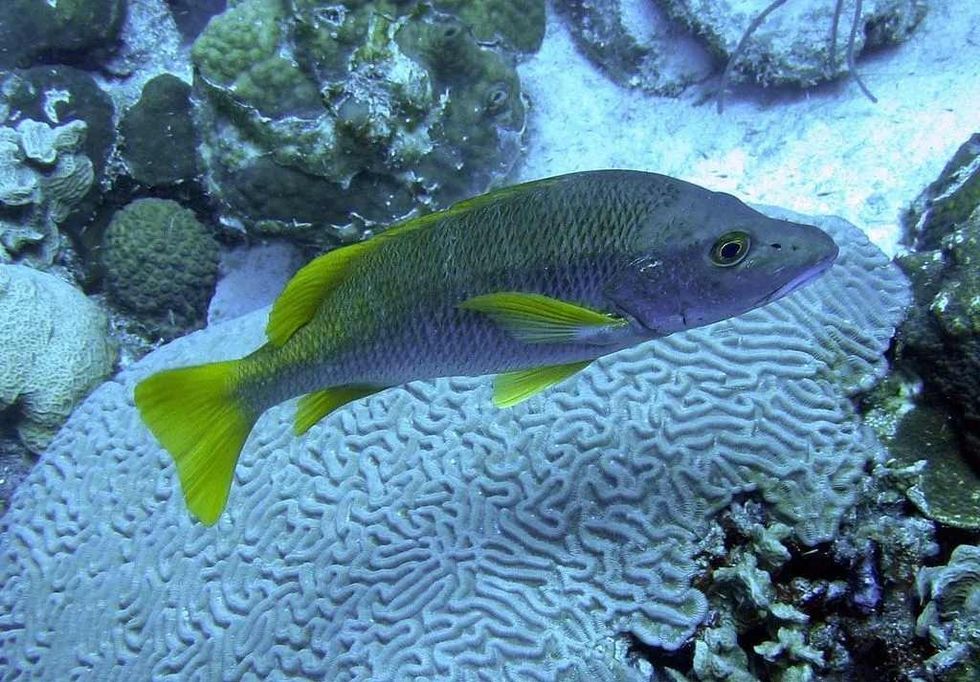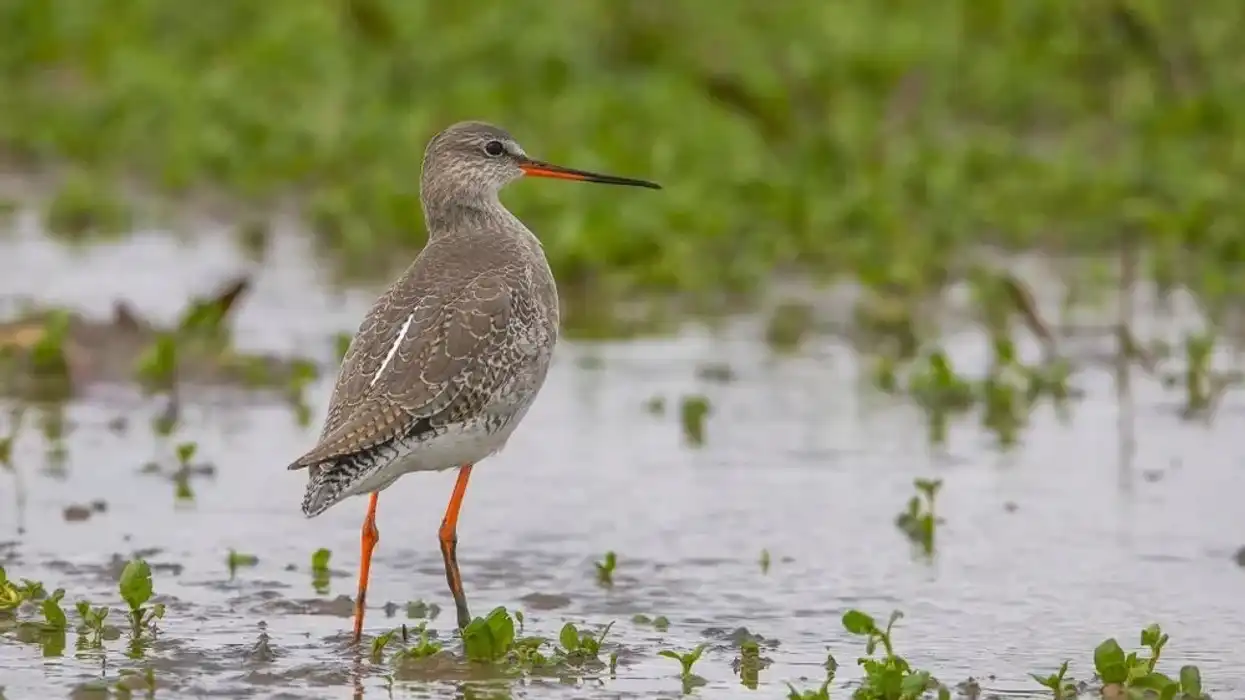Schoolmaster snappers are pretty little fishes that belong to the Lutjanidae snapper family. These are ray finned fishes and have been coined the scientific name of Lutjanus apodus.
These fishes are found in coastal, tropical, and temperate waters, such as in the Atlantic Ocean, the coast of Mexico, Florida Keys (Florida), the Caribbean, and the Bahamas. They can also be found in the muddy waters around Mangrove areas and above coral reefs.
The schoolmaster snapper is characterized by its olive gray body, a deep blue line extending from its snout to its tail, and its yellow tinge. They are carnivorous in nature, with a diet consisting of gastropods, cephalopods, worms, insects, and so on.
Read further to discover some fun facts about the schoolmaster snapper, and do check out our mutton snapper and mangrove snapper articles.
Schoolmaster Snapper Interesting Facts
What type of animal is a schoolmaster snapper?
The schoolmaster snapper (Lutjanus apodus) is a ray finned fish belonging to the Lutjanidae snapper family.
What class of animal does a schoolmaster snapper belong to?
The schoolmaster snapper (Lutjanus apodus) is a ray finned fish belonging to the Actinopterygii class and genus Lutjanus.
How many schoolmaster snappers are there in the world?
The exact number of these fish is not known. However, they have a stable population that is distributed across the shallow clear warm coastal waters and coral reefs of the Atlantic, Gulf of Mexico, Florida, the Caribbean, and the Bahamas.
Where does a schoolmaster snapper live?
These fish can be found in the open water and coral reefs of the Western Atlantic Ocean, from Massachusetts to the Gulf of Mexico (Florida keys to Tampa, Florida), the Bahamas, and the Caribbean sea.
What is a schoolmaster snapper's habitat?
The schoolmaster snapper (Lutjanus apodus) lives in shallow, clear warm coastal waters and along the coral reefs in the sea. They are also found in mangrove areas with sand bottoms.
Who do schoolmaster snappers live with?
Schoolmaster snappers are often found in large groups or schools of fish. These large schools are formed to prevent these fish from getting eaten by predators. They swim across the ocean throughout the day, and separate ways at night to forage for food such as gastropods and cephalopods.
How long does a schoolmaster snapper live?
These fish are considered to be long lived species, which means that they have a very long lifespan. The longest living fish of this species lived up to 42 years. Other long lived fish include the bigmouth buffalo fish, the oscar fish, and the sturgeon.
How do they reproduce?
These fish reproduce oviparously, which means that they reproduce by means of eggs. Male and female adults release their sperm and eggs in the open water simultaneously. Once fertilized, these eggs settle on the sandy bottoms, where they are left alone until they hatch. The breeding season takes place in the summer from April to June.
What is their conservation status?
The fish of this species is not threatened by humans and are not popular for commercial use. Hence, they have a stable population and have been classified as Least Concern by the IUCN.
Schoolmaster Snapper Fun Facts
What do schoolmaster snappers look like?
The fish of this species are average sized, with a yellow or reddish head and an olive gray back and side. They have a compressed body with a long, lean snout.
They also have large mouths, with large, sharp upper canine teeth and smaller back teeth. They may also have eight stripes on the sides of their bodies, although these may be faded in adults of this species. They have bright yellow tails and fins, with a blue striped snout.
They also have a blue line extending from their snout. These fish grow between the range of 14-31 in (35-79 cm) and can reach a maximum weight of 24 lb (10.8 kg).

How cute are they?
The fish of this species is not considered to be cute, but are considered to be very beautiful in the water due to their bright red and yellow tones. The wide range of colors on the body of this fish makes it a very beautiful sight in the deep blue sea.
The olive gray bodies of large adults also prove to be very attractive to look at in the water.
How do they communicate?
Although the exact method of communication between these fish is not known, it can be speculated that adults use a combination of chemical signatures and vibrations in the water to communicate with each other.
How big is a schoolmaster snapper?
The fish of this species can grow to a length within the range of 14-31 in (35-79 cm) and a maximum weight of 24 lb (10.8 kg). However, the average weight of this species is around 5 lb (2.26 kg). This makes them almost seven times smaller than the Patagonian toothfish by length.
How fast can a schoolmaster snapper swim?
The exact speed of a schoolmaster snapper is unknown.
How much does a schoolmaster snapper weigh?
These fish have a weight that can range from an average of 5 lb (2.3 kg) to a maximum weight of 24 lb (10.8 kg).
What are the male and female names of the species?
There are no specific names for the male and female adults of this species. They are simply referred to as male or female.
What would you call a baby schoolmaster snapper?
The are no specific names for these baby fish. They are simply referred to as juveniles or fry.
What do they eat?
These fishes are carnivorous in nature and have developed sharp canine teeth to tear through flesh. Hence, these fishes eat other small fishes, worms, cephalopods, gastropods, crabs, and so on. Large adults mainly eat smaller fish.
Are they poisonous?
No, these fishes are not poisonous or harmful. They are harmless to fish that mostly keep to themselves.
Would they make a good pet?
These fish can be caught and kept as pets. Although, they are not popular pets. Instead, these fish are caught to be eaten as they are considered to be very tasty.
Did you know...
Schoolmaster snappers are extremely tasty, and hence, are often caught as a food fish. However, due to their popularity, government regulations restrict the fishing of these snappers to only 10 fish per person in the Western Atlantic and the Gulf of Mexico.
Catching and eating schoolmaster snappers
Schoolmaster Snappers are a popular food fish and game fish. They are considered to be very tasty, and hence, are often caught to be eaten.
These fish are strong and can put up a good fight, so if you want to catch one of these fish, you should use hand lines, gill nets, traps, or beach seines. For bait, you can use chum, shrimp, anchovies, and crawfish.
Do snapper fish have teeth?
Yes, these fish have teeth. They have sharp, large upper canines at the front of their mouth because they are aggressive carnivores, and need these upper canine teeth to tear through flesh. They have smaller teeth at the back of their mouth.
Here at Kidadl, we have carefully created lots of interesting family friendly animal facts for everyone to discover! For more relatable content, check out these brown trout facts or Atlantic cod facts pages.
You can even occupy yourself at home by coloring in one of our free printable snapper coloring pages.









